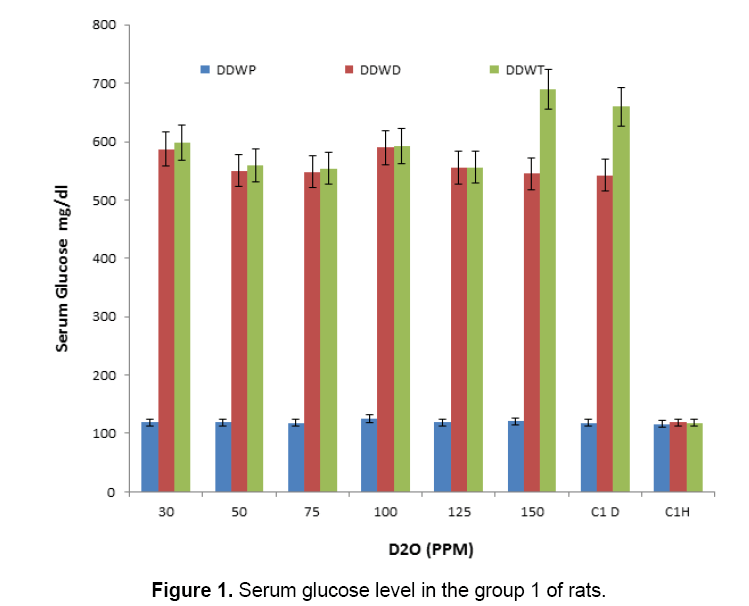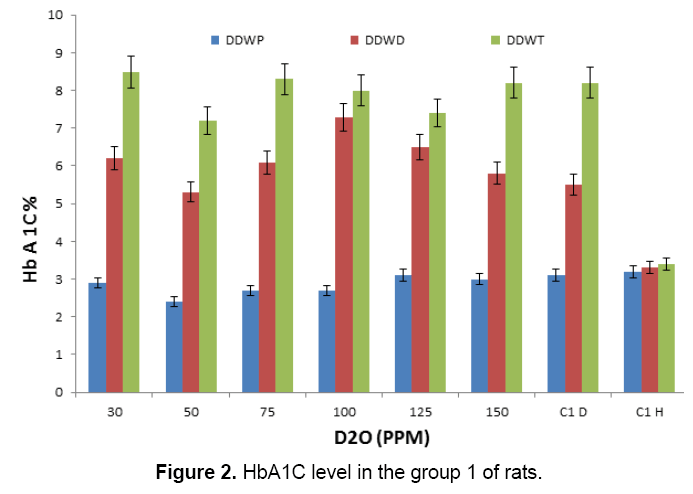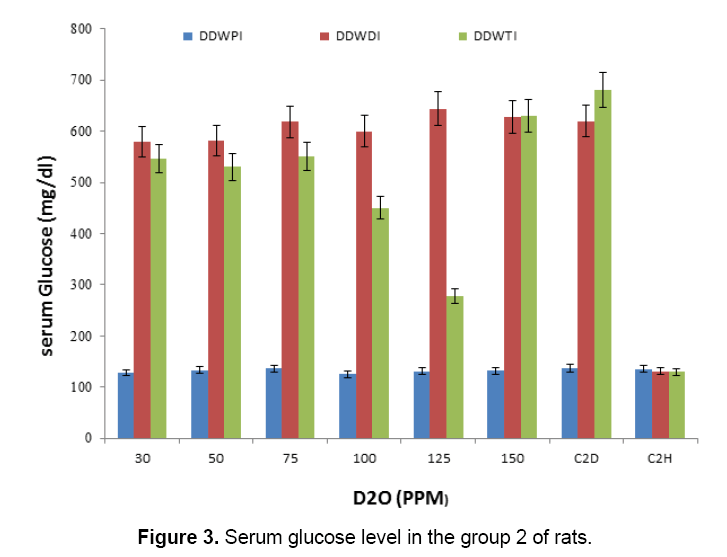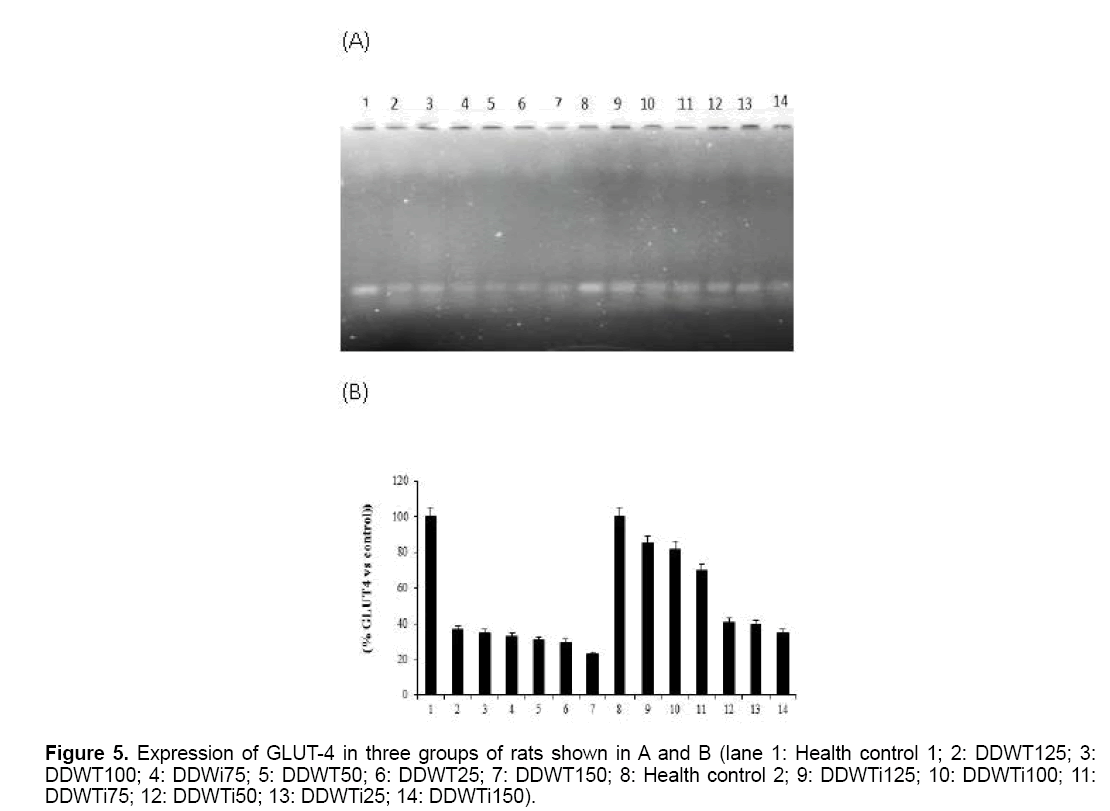Decreasing of Deuterium Concentration of Water: A Possible Tool in Diabetes Therapy
Kamal Yavari, Mehrdad Gholamali, Fatemeh Yazdian
1Nuclear Biochemistry Lab, Nuclear Science and Technology Research Institute (NSTRI), North Kargar Street, Tehran, Iran
2Faculty of New Sciences and Technologies (FNST), University of Tehran, Iran
- Corresponding Author:
- Tel: +98-9125478314
E-mail: kyavari@aeoi.org.ir
Received date: May 31, 2017; Accepted date: August 29, 2017; Published date: September 05, 2017
Citation: Yavari K, Gholamali M, Yazdian F. The Biological Effects of Deuterium Depleted Water: A Possible Tool in Diabetes Therapy. Electronic J Biol, 13:4
Abstract
Background: Developing new diabetes care agent is of great importance and incites increasing demand for new products to improve the diabetes care. Several compounds have been made and investigated for this purpose. DDW is a type of water that has several health benefits and has been used for medicinal purposes in recent years. The aim of this study is to test the effect of removal of D2O on the glucose metabolism in sreptozotocin (STZ)-induced diabetic rat model and to explore the possible mechanism. Methods: Diabetes was induced by a single i.p., injection of 60 mg/kg body weight of STZ. After 2 weeks, animals were randomly distributed into several groups to test the effect of D2O (25-150 ppm) on glucose metabolism in diabetic animals with or without insulin treatment. The serum glucose and HbA1C parameters were tested and at the end of 8 weeks of intervention, the expression of membrane associated GLUT-4 mRNA detected by semi-quantitative RT-PCR. Results: Our results indicate that STZ treatment significantly increased serum glucose and HbA1C. Depletion of D2O has minor influence on the measured parameters in animals not received insulin. However the measured parameters were significantly lower in those animals received lower D2O containing drinking water and insulin treatment. The membrane associated GLUT-4 was significantly higher in these animals also. Conclusions: These data suggest that D2O depletion enhance insulin effect on GLUT-4 translocation and potentiate glucose uptake in diabetic animals, provided good evidence for its potential use in diabetes care.
Keywords
Diabetes; Deuterium-depleted water; Glucose; HbA1C; GLUT-4.
1. Introduction
Diabetes describes a group of metabolic diseases in which the person has high blood glucose. Diabetes develops when the body doesn't make enough insulin or is not able to use insulin effectively (insulin resistance, relative lack of insulin) or both. Due to the absolute or relative lack of insulin the cells are unable to take up glucose, that is why the blood glucose level increases (hyperglycemia) leading to the symptoms of the disease. In these instances the patient blood glucose level is higher than the normal range of 3.5- 6.5 mMol/l. It is common for persons in this diseases group that, in spite of different pathogenesis, they cannot secret the amount of insulin required by their metabolic processes or insulin, although present, has no effect. Several factors that have effect on the insulin action/synthesis [1-8].
2. Materials and Methods
2.1 Chemicals and reagents
STZ were purchased from Sigma, RNA extraction kit were obtained from QiaGene (Tehran, Iran); DNase I, RNase free kit were purchased from Fermentas (Ontario, Canada), RT kit and primers from Bioneer (Daejon, Korea), dNTPs from BioFlux (Tokyo, Japan). All other chemicals and solvent were of the highest commercial grade from Merck (KGaA, Germany) or from Sigma (St Louis, Mo, USA).
Deuterium-depleted water: DDW was produced by Mesbah Company in concentration of 30-150 ppm of deuterium content.
2.3 Animals
Male Wistar rats, weighing 200-250 g (Pasteur Institute, Tehran, Iran) were used in this study. Animals were housed three per standard rat cage, in a 12:12 h light-dark cycle nd controlled temperature (22 ± 1°C). Commercial rodent pellets and tap water were available and libitum. They were allowed to adapt to the laboratory conditions for one week before beginning of the study. There were eight rats per group in each experiment. The procedures were performed in accordance with institutional guidelines for animal care and use.
2.4 Preparation of STZ-induced diabetic rats
Diabetes was induced by a single i.p., injection of STZ (60 mg/kg body weight).
2.5 Experimental design
Rats were randomly divided into the following two groups, each group consisting of eight subgroup with three animals in anyone.
Group 1: In this group, rats, dependent on step of examinations, were including:
Subgroup 1-1: In this step, all of the rats were healthy (prediabetic step; two week before of diabetes induction) and consisted of these species; DDW30, DDW50, DDW75, DDW100, DDW125, DDW150, DDW control (C1H) and control 2(C2D).
Subgroup 1-2: in this step, all of the rats except control1 were diabetic and named as; DDW30, DDW50, DDW75, DDW100, DDW125, DDW150, DDW control 1 and DDWD control 2.
Subgroup 1-3: Diabetic rats treated with DDW alone and named as:
DDWT30, DDWT50, DDWT75, DDWT100, DDWT125, DDWT150, DDWT control 1(C2H) and DDWD (control 2).
Group 2: In this group, rats, dependent on step of examinations, were including:
Subgroup 2-1: in this step all of the rats are healthy (prediabetic; two week of before of diabetes induction) and are; DDWi30, DDWi50, DDWi75, DDWi100, DDWi125, DDWi150, DDWi control 1 and control 2.
Subgroup 2-2: In this step all of the rats except control1 were diabetic and named as; DDWi30, DDWi50, DDWi75, DDWi100, DDWi125, DDWi150, DDWi control 1 and DDWDi control 2.
Subgroup 2-3: Diabetic rats treated with DDW along insulin and including: DDWTi30, DDWTi50, DDWTi75, DDWTi100, DDWTi125, DDWTi150, DDWTi (control 1i) 1 and DDWDTi (control 2).
In the 1-1, 1-2, 2-1, 2-2 all of rats and also rats of control 1, control 1(i), DDWD control 2 and DDWDi control2 were fed with commercial rodent pellets and tap water in all time of study. The rats of treatment step, except control subgroups, treated with various concentration of DDW.
All of examination in two groups was done with parallel.
Administration of the DDW; DDW was administered orally to rats in treatment step for 8 weeks.
2.6 Measurement of glucose and HbA1C
The serum glucose and HbA1C parameters were tested in prediabetic (2 weeks before of diabetes induction), diabetic (two week after of diabetes induction) and treated rats (for 8 weeks) in all of the rats. Blood samples were obtained from the tail vein and glucose and HbA1C levels were measured with glucosoxidase and immunoturbidometry technique, respectively.
2.7 Gene expression
To investigate the mechanism of DDW anti -hyperglycemic action, at the end of 8 weeks of treatment, all of the animal’s two groups were analyzed for soleus membrane Glut-4 mRNAs expression by RT-PCR (Reverse Transcription Polymerase Chain Reaction) technique.
2.8 Statistical analysis
All data are presented as mean ± SD. For 8 animals in each group. Comparisons between time points were by one-way analysis of variance (ANOVA) followed by Duncan’s test to analyze the difference. Differences were considered significant when P-values were less than 0.05. All statistical analyses were performed using SPSS19.
3. Results and Discussion
The aim of research was to reveal anti-hyperglycaemic effects of DDW and also the molecular mechanism of the processes induced by lowered D concentration.
In this study administration of STZ significantly increased the blood glucose and HbA1C levels in rats. The stimulation of experimental diabetes in rat, using chemicals that selectively destroy pancreatic β-cell is very convenient and simple to use. The most usual substance to induce diabetes in rats is streptozotocin. Diabetic rats treated with DDW alone and with insulin. In the results of Figure 1 in group 1 of rats, it can be seen that blood glucose levels in diabetic rats have increased in all rats. By analyzing the results of the post-treatment analysis, we find that blood glucose levels in rats of group 1 are different. Blood glucose levels have increased in rats fed with deuterium-depleted water at concentrations of 30, 50, 150 ppm and also diabetic control. In rats that fed with deuterium water at concentrations of 100, 75 and 125 ppm, glucose levels have decreased slightly, especially in rats that faded with depleted water in 125 ppm concentration of DDW. We find that inhibited blood glucose levels are seen in comparison with other rats. As predicted, there was no change in blood glucose levels in healthy control rats. Also, rats drinking 150 ppm of water had significantly increased their blood glucose levels. It is observed that the rate of reduction in blood glucose in rats drinking 100 ppm water was higher than ones treated with 75 ppm of DDW.
The results of Figure 2 show the variation in HbA1C in group 1 of rats. Its blood levels have increased in all rats during diabetic induction. After the treatment with DDW alone, the blood level of HbA1C increased in all rats in group1, but this increase in rats that consumed deuterium water with a concentration of 125 ppm, was lower than other rats. No change was in the blood HbA1C levels in the healthy control rats. Also, in rats drinking 150 ppm of DDW, blood HbA1C levels increased compared to other rats. It was observed that the rate of increase in HbA1C in rats drinking 100 ppm water was less than ones with fed 75 ppm of DDW.
Figure 3 shows the changes in glucose levels in group 2 of rats. The results indicated that blood glucose levels in diabetic rats have increased in all rats. In the DDWi treatment rats, it can be seen that blood glucose levels are different. Blood glucose increased in rats that drinking deuterium water with 150 ppm concentrations and diabetic control. It is observed that in the rats that received both DDW and insulin, blood glucose levels have decreased. The rats that fed with deuterium water at a concentration of 125 and 100 ppm had greater amount of glucose lowering. Particularly, in the rat’s drinking deuterium water at a concentration of 125 ppm, the amount of glucose significantly decreased. No changes in blood glucose levels have been observed in healthy control rats. As predicted, there was no change in blood glucose levels in healthy control rats. In group 2 rats, also, in rats receiving 30 and 50 ppm of DDW, glucose level was reduced.
By observing the results of Figure 4, in the rats of group 2, it can be seen that blood levels of HbA1C have increased in all rats during diabetic step. After treatment rats of group 2 with both insulin and DDW, it can be seen that HbA1C is changes in different rats. In the rat receiving insulin and DDW with concentrations of 30, 50 and 150 ppm and also in diabetic control rats, the HbA1C is increased. HbA1C level reduced in the rat receiving insulin and DDW at concentrations of 75, 100 and 125 ppm and the highest reduction was observed in the rats drinking deuterium water with a concentration of 125 ppm. There was no change in blood HbA1C levels in healthy control rats. It is observed that the reduction in HbA1C in the rats drinking 100 ppm of water is higher than it in rats fed with 75 ppm and 50 ppm. Also, the HbA1C blood levels increased in rats drinking 150ppm water more than of rats dirking DDWi with 30 and 50 ppm of deuterium.
Results of this study indicated that depletion of D2O alone has minor influence on the measured parameters in animals not received insulin. Figures 1-4 depicts glucose and HbA1C amounts in group 1 of rats. As shown in these figures, the effects of DDW alone in various concentrations on the glucose and HbA1C amounts are not significant with compromised with diabetic control (P>0.05) and are very high relative to amount of them in health control subgroups (P<0.001).
However lowering of the D2O content of waster caused a significant reduction of the blood glucose and HbA1C in insulin treated rats (group 2 of rats) in a dose dependent manner. The highest effect was shown in 125 ppm of D2O. The statistical analysis showed compared to the diabetic rats, the amounts of glucose (p<0.001) and HbA1C (p<0.01) in the DDWTi 125 ppm treated rats were reduced significantly.
To reveal the molecular of the processes induced by lowered D concentration, the effect of D depletion on GLUT4 was investigated in streptozotocin (STZ) treated rats lacking insulin production (Figures 4 and 5). The results indicated that the lowering of D2O promoted the expression of GLUT4 in soleus muscle of DDW treated animals. In STZ-treated rats consuming normal water and DDW alone the amount of GLUT4 was less than 45% of the health control (p<0.001).
However In STZ-treated rats consuming DDW (30, 75, 105, 125 ppm) with insulin injection, GLUT4 amount was higher than in the STZ-control (150 ppm) group (p<0.001). Taken tougher, our results suggest that the molecular mechanism of D2O depletion in the glucose and HA1C reduction is the enhancement of GLUT4 expression and potentiate glucose uptake in the peripheral tissue of diabetic animal.
4. Conclusion
DDW provide a method for treating and preventing the diseases such as diabetes mellitus, are usually coped with surgery, radiation treatments, medicinal treatments, and the like, and in these cases, patients visit directly to hospitals or clinics and receive treatments. These problems can be solved by using deuterium depleted water as the raw material can be used for the treatment and prevention of the diabetes mellitus.
References
- Gregory P, Forlenza A, Marian R. (2011). Current opinion in endocrinology, diabetes and obesity. Curr Opin Endocrinol Diabetes Obes. 248: 1752-2978.
- Kahn R. (2013). Type 2 diabetes in children and adolescents. World J Diabetes. 154: 270-281.
- Gunasekaran U, Gannon M. (2011). Type2 diabetes and the aging pancreatic beta cell. Aging. 3: 565-575.
- Virally M, Laloi MM. (2010). Methods for the screening and diagnosis of gestational diabetes mellitus between 24 and 28 weeks of pregnancy. Diabetes Metabol. 36: 549–565.
- National Diabetes Data Group. (1995). Diabetes in America, 2nd Edn. Bethesda National Institutes of Health. 95: 1468.
- Mohammad NA. (2013). Effects of treatment of overt hypothyroidism on insulin resistance. World J Diabetes. 157-161.
- Buschard K. (2011). What causes type 1 diabetes? Lessons from animal models. APMIS. 119: 1-19
- Expert Committee on the Diagnosis and Classification of Diabetes Mellitus. (1997). Report of the expert committee on the diagnosis and classification of diabetes mellitus. Diabetes Care. 20: 1183-1195.
- Ignat I, Oleg M, Borislav V, et al. (2017). Influence of isotopic composition of water with varying deuterium content in composition with mountain water of Bulgaria on human longevity. J Med Physiol Biophys. 7: 46-67
- Atkison MA, Malaren NK. (1994). The pathogenesis of non-insulin dependent diabetes. N Engl J Med. 331: 1428-1436.
- Obberghen G, Somers, Devism G, et al. (1974). Dynamics of insulin release and microtubular-microfilamentous system VI Effect of D2O. Endocrinl. 95: 1518-1528.
- Somlyai G, Jancsó G, Jákli G, et al. (1993). Naturally occurring deuterium is essential for the normal growth rate of cells. FEBS Lett. 317: 1-4.
- Oxana, Ekaterina B, Denis S, et al. (2014). Changes of oxidation during use the food diet with deuterium depleted water in laboratory animals with purulent inflammation. Russian Open Med J. 3:1-6.
- Olariu L, Petcu M, Tulcan C, et al. (2007).Deuterium depleted water – Antioxidant or pro-oxidant. Lucrari st Med Vet. 265-269.
- Avila DS, Somlyai G, Somlyai I, et al. Anti-aging effects of deuterium depletion on Mn-induced toxicity in C. elegans model. Toxicol Lett. 211: 319-24.
- Krempels K, Somlyai I, Somlyai G. (2008). A retrospective evaluation of the effects of deuterium depleted water consumption on 4 patients with brain metastases from lung cancer. Integr Cancer Ther. 7: 172-181.
- Cong FS, Zhang YR, Sheng HC, et al. (2010). Deuterium-depleted water inhibits human lung carcinoma cell growth by apoptosis. Exp Ther Med. 1: 277-283.
- Kovács A, Guller I, Krempels K, et al. (2011). Deuterium depletion may delay the progression of prostate cancer. J Cancer Ther. 2: 548-556.
- Gyongyi Z, Somlyai G. (2000). Deuterium depletion can decrease the expression of c-myc, Ha-ras and p53 gene in carcinogen-treated mice. In Vivo. 14: 437-340.
- Gyongyi Z, Budan F, Szabo I, et al. (2013) Deuterium depleted water effects on survival of lung cancer patients and expression of Kras, Bcl2 and Myc genes in mouse lung. Nutr Cancer. 65: 240-246.
- 2nd International Congress on Deuterium Depletion. (2012). Eur Chem Bull. 1: 39-47.
- https://www.b3cnewswire.com/20100616313/1st-international-symposium-on-deuterium-depletion-deuterium-depletion-a-new-possibility-in-health-science.html

Open Access Journals
- Aquaculture & Veterinary Science
- Chemistry & Chemical Sciences
- Clinical Sciences
- Engineering
- General Science
- Genetics & Molecular Biology
- Health Care & Nursing
- Immunology & Microbiology
- Materials Science
- Mathematics & Physics
- Medical Sciences
- Neurology & Psychiatry
- Oncology & Cancer Science
- Pharmaceutical Sciences





